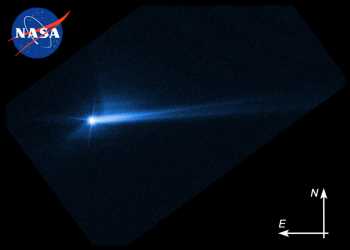NASA has confirmed that the Double Asteroid Redirection Test (DART) spacecraft’s artificial impact on Dimorphos, the asteroid moonlet of Didymos, has successfully altered its orbit as planned.
DART crashed into its target asteroid in an experimental mission that the U.S. space agency conducted on September 26.
Prior to DART’s impact, it took Dimorphos 11 hours and 55 minutes to orbit its larger parent asteroid, Didymos. Since DART’s intentional collision with Dimorphos, astronomers have been using telescopes on Earth to measure how much that time has changed.
Analysis of data obtained over the past two weeks by the DART investigation team showed that the spacecraft’s kinetic impact altered Dimorphos’ orbit around Didymos by 32 minutes.
Before its encounter, NASA had defined a minimum successful orbit period change of Dimorphos as change of 73 seconds or more. This early data show DART surpassed this minimum benchmark by more than 25 times.
“This result is one important step toward understanding the full effect of DART’s impact with its target asteroid” said Lori Glaze, director of NASA’s Planetary Science Division at NASA Headquarters in Washington. “As new data come in each day, astronomers will be able to better assess whether, and how, a mission like DART could be used in the future to help protect Earth from a collision with an asteroid if we ever discover one headed our way,” she added.
The investigation team is still acquiring data with ground-based observatories around the world – as well as with radar facilities at NASA Jet Propulsion Laboratory’s Goldstone planetary radar in California and the National Science Foundation’s Green Bank Observatory in West Virginia. They are updating the period measurement with frequent observations to improve its precision, NASA said in a press release.
Focus now is shifting toward measuring the efficiency of momentum transfer from DART’s roughly 14,000-mile (22,530-kilometer) per hour collision with its target. This includes further analysis of the “ejecta” – the many tons of asteroidal rock displaced and launched into space by the impact. The recoil from this blast of debris substantially enhanced DART’s push against Dimorphos – a little like a jet of air streaming out of a balloon sends the balloon in the opposite direction.
Source: Read Full Article
-
Netflix, Disney, Warner Bros Discovery, Amazon & Other Studios Dodge Abortion Safety Plan Appeal From Shonda Rhimes, Natasha Lyonne, Mindy Kaling, Ava DuVernay & Hundreds Of Female Showrunners & Scribes
-
Suzanne Malveaux To Depart CNN After 20 Years
-
On a hat-trick: Will Das throw up another surprise?
-
18 Reasons to Drink Coffee for Your Health
-
Asian Shares Mixed On Lingering Fed Concerns

